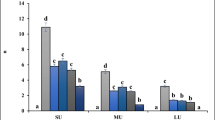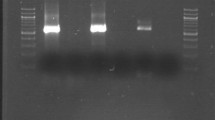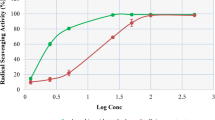Abstract
The recent studies have indicated the properties of ethnomedicinal plants in the prevention, control, and treatment of gastroduodenal ulcers. Glycyrrhiza glabra has been used in Iranian traditional medicine as a therapeutic supplement. The aim of our research was to survey the preventive property of aqueous extract of G. glabra leaf on ibuprofen-induced gastroduodenal ulcers by investigating the biochemical, hematological, immunological, and microscopic approaches in rats. In this study, 60 rats were used. The animals were randomly divided into six subgroups, including negative healthy control, untreated negative control, the positive control receiving omeprazole 60 mg/kg, and three groups receiving the G. glabra aqueous extract at 20 mg/kg, 60 mg/kg, and 180 mg/kg concentrations. After 14 days, gastroduodenal ulcers were caused by ibuprofen 400 mg/kg. Four hours after oral administration of ibuprofen, the rats were sacrificed and blood, stomach, and duodenum samples of them collected for analysis of biochemical, hematological, immunological, and microscopic parameters. The data were analyzed by SPSS 21 software. All doses of G. glabra could significantly (p ≤ 0.05) reduce the raised levels of ALP, AST, ALT, GGT, cholesterol, LDL, triglyceride, total and conjugated bilirubin, urea, creatinine, IL-1, IL-6, IL-12, IL-18, IFN-γ, and TNF-α and increase HDL, total protein, albumin, WBC, platelet, RBC, IL-4, IL-5, IL-10, IL-13, and IFN-α as compared to the untreated group. Also, aqueous extract of G. glabra prevented significantly (p ≤ 0.05) gastroduodenal ulcers as compared to the untreated group. In conclusion, the obtained results indicated the hepatoprotective, nephroprotective, hematoprotective, immunoprotective, and gastroduodenal protective properties of G. glabra aqueous extract.












Similar content being viewed by others
References
Abd-Al-Sattar Sadiq Layl L (2016) Hepatoprotective effect of Glycyrrhiza glabra L. extracts against carbon tetrachloride-induced acute liver damage in rats. Int J Vet Sci 1(1):1–8
Adams RJ, Appleton SL, Gill TK, Taylor AW, Wilson DH, Hill CL (2011) Cause for concern in the use of non-steroidal anti-inflammatory medications in the community—a population-based study. BMC Fam Pract 12:70
Alqasoumi S, Al-Sohaibani M, Al-Howiriny T, Al-Yahya M, Rafatullah S (2009) Rocket “Eruca sativa”: a salad herb with potential gastric anti-ulcer activity. World J Gastroenterol 15(16):1958–1965
Anderson MD, Piper SE, Swan GE (2005) Nonsteroidal anti-inflammatory drug use in South Africa and possible effects on vultures. S Afr J Anim Sci 101:112–114
Anil K, Jyotsna D (2012) Review on Glycyrrhiza glabra. J Pharm Sci Innov 1(2):1–4
Aprioku JS, Uche FI (2013) Renal effects of nonsteroidal antiinflammatory drugs in albino rats. Br J Pharm Res 3(3):314–325
Asl MN, Hosseinzadeh H (2008) Review of pharmacological effects of Glycyrrhiza sp. and its bioactive compounds. Phytother Res 22(6):709–724
Bendele MA, Hulman JF, White S, Brodhecker C, Bendel RA (1993) Hepatocellular proliferation in ibuprofen-treated mice. Toxicol Pathol 21(1):15–20
Bennett W, Henrich WL, Stoff JS (1996) The renal effects of nonsteroidal anti-inflammatory drugs: summary and recommendations. Am J Kidney Dis 28(1 Suppl 1):56–62
Boshra SA, Hussein MA (2014) The protective role of colchicine on diclofenac sodium induced hepatorenal toxicity in albino rats model. Int J Pharm Sci Res 5(12):5136–5144
Bushra R, Aslam N (2010) An overview of clinical pharmacology of ibuprofen. Oman Med J 25(3):155–161
Capone ML, Tacconelli S, Di-Francesco L, Sacchetti A, Sciulli MG, Patrignani P (2007) Pharmacodynamic of cyclooxygenase inhibitors in humans. Prostaglandins Other Lipid Mediat 82(1–4):85–94
Chen HJ, Kang SP, Lee IJ, Lin YL (2014) Glycyrrhetinic acid suppressed NF-kappaB activation in TNF-alpha-induced hepatocytes. J Agric Food Chem 62(3):618–625
Dehghani-Tafti L, Shariatpanahi SM, Mahdavi-Damghani M, Javadi B (2017) Traditional Persian topical medications for gastrointestinal diseases. Iran J Basic Med Sci 20(3):222–241
Dwivedi V, Mishra J, Shrivastava A (2015) Efficacy study of livartho against paracetamol induced hepatotoxicity in adult Sprague Dawley rats. J Drug Metab Toxicol 5(6):175–181
El-Maddawy ZKH, El-Ashmawy IM (2013) Hepato-renal and haematological effects of diclofenac sodium in rats. Global J Pharmacol 7(2):123–132
Farzaei MH, Zangeneh MM, Goodarzi N, Zangeneh A (2018) Stereological assessment of nephroprotective effects of Trachyspermum ammi essential oil against carbon tetrachloride-induced nephrotoxicity in mice. Int J Morphol 36(2):750–757
Graham GG, Davies MJ, Day RO, Mohamudally A, Scott KF (2013) The modern pharmacology of paracetamol: therapeutic actions, mechanism of action, metabolism, toxicity and recent pharmacological findings. Inflammopharmacol 21(3):201–232
Hamelian M, Zangeneh MM, Amisama A, Varmira K, Veisi H (2018) Green synthesis of silver nanoparticles using Thymus kotschyanus extract and evaluation of their antioxidant, antibacterial and cytotoxic effects. Appl Organometal Chem 32. https://doi.org/10.1002/aoc.4458
Hörl WH (2010) Non-steroidal anti-inflammatory drugs and the kidney. Pharma 3(7):2291–2321
Hull S, Mathur R, Dreyer G, Yaqoob MM (2014) Evaluating ethnic differences in the prescription of NSAIDs for chronic kidney disease: a cross-sectional survey of patients in general practice. Br J Gen Pract 64:448–455
Huo HZ, Wang B, Liang YK, Bao YY, Gu Y (2011) Hepatoprotective and antioxidant effects of licorice extract against CCl4-induced oxidative damage in rats. Int J Mol Sci 12(10):6529–6543
Jung JC, Lee YH, Kim SH, Kim KJ, Kim KM, Oh S, Jung YS (2016) Hepatoprotective effect of licorice, the root of Glycyrrhiza uralensis Fischer, in alcohol-induced fatty liver disease. BMC Complement Altern Med 16. https://doi.org/10.1186/s12906-016-0997-0
Li YJ, Chen J, Li Y, Li Q, Zheng YF, Fu Y, Li P (2011) Screening and characterization of natural antioxidants in four Glycyrrhiza species by liquid chromatography coupled with electrospray ionization quadrupole time-offlight tandem mass spectrometry. J Chromatogr A 11:8181–8191
Liu H, Wang J, Zhou W, Wang Y, Yang L (2013) Systems approaches and polypharmacology for drug discovery from herbal medicines: an example using licorice. J Ethnopharmacol 146(3):773–793
Matsuda H, Kubo M (1984) Pharmacological study on Panax ginseng C. A. Meyer. II. Effects of red ginseng on the experimental gastric ulcer (1). Yakugaku Zasshi 104(5):449–453
Mizui T, Sato H, Hirose F, Doteuchi M (1987) Effect of antiperoxidative drugs on gastric damage induced by ethanol in rats. Life Sci 41(6):755–763
Montoro P, Maldini M, Russo M, Postorino S, Piacente S, Pizza C (2011) Metabolic profiling of roots of liquorice (Glycyrrhiza glabra) from different geographical areas by ESI/MS/MS and determination of major metabolites by LC-ESI/MS and LC-ESI/MS/MS. J Pharm Biomed Anal 54(3):535–544
Moradi R, Hajialiani M, Salmani S, Almasi M, Zangeneh A, Zangeneh MM (2018) Effect of aqueous extract of Allium saralicum R.M. Fritsch on fatty liver induced by high-fat diet in Wistar rats. Com Cli Pathol. https://doi.org/10.1007/s00580-018-2834-y
Orinya OA, Adenkola AY, Ogbe RJ (2016) Haematological and biochemical studies on the effect of diclofenac sodium on Wistar Rattus norvegicus. Int J Biol Chem Sci 10(5):2231–2242
Patel K, Diamantidis C, Zhan M, Hsu VD, Walker LD, Gardner J, Weir MR, Fink JC (2012) Influence of creatinine versus glomerular filtration rate on non-steroidal anti-inflammatory drug prescriptions in chronic kidney disease. Am J Nephrol 36(1):19–26
Reeves BC, Deeks JJ, Higgins JPT, Wells GA (2008) Including non-randomized studies. In: Cochrane handbook for systematic reviews of interventions. Wiley, Chichester, pp 389–432
Reynolds EF (1982) Aspirin and similar analgesic and anti-inflammatory agents. In: Martindale. The extra pharmacopoeia, 28th edn. Pharmaceutical, London, pp 234–282
Samadnejad AZ, Mehrvarz S, Naeini SA, Tanideh N (2012) Healing effect of licorice extract in acetic acid-induced ulcerative colitis in rat. Res Pharm Sci 7(5):837–845
Sayyedrostami T, Pournaghi P, Ebrahimi Vosta-Kalaeea S, Zangeneh MM (2018) Evaluation of the wound healing activity of Chenopodium botrys leaves essential oil in rats (a short-term study). J Essent Oil Bear Plants 21(1):164–174
Shafi M, Garg UK, Saqib N, Baba OK, Farid BD, Wali A (2012) Haemato-biochemical studies on diclofenac, ibuprofen and nimesulide induced toxicity in broilers. Nat Environ Pollut Technol 11(4):649–652
Sherkatolabbasieh H, Hagh-Nazari L, Shafiezadeh S, Goodarzi N, Zangeneh MM, Zangeneh A (2017) Ameliorative effects of the ethanolic extract of Allium saralicum R.M. Fritsch on CCl4-induced nephrotoxicity in mice: a stereological examination. Arch Biol Sci 69(3):535–543
Sirota L, Shacham D, Punsky I, Bessler H (2001) Ibuprofen affects pro- and anti-inflammatory cytokine production by mononuclear cells of preterm newborns. Biol Neonate 79(2):103–108
Sonnenberg A, Chicarro ML (1991) Peptic ulcer in the United States. Rev Esp Enferm Dig 79(5):341–349
Swan SK, Rudy DW, Lasseter KC, Ryan CF, Buechel KL, Lambrecht LJ, Pinto MB, Dilzer SC, Obrda O, Sundblad KJ, Gumbs CP, Ebel DL, Quan H, Larson PJ, Schwartz JI, Musliner TA, Gertz BJ, Brater DC, Yao SL (2000) Effect of cyclooxygenase-2 inhibition on renal function in elderly persons receiving a low-salt diet. A randomized, controlled trial. Ann Intern Med 133(1):1–9
Thanagari BS, Fefar DT, Prajapati KS, Jivani BM, Thakor KB, Patel JH (2012) Haemato-biochemical alterations induced by diclofenac sodium toxicity in Swiss albino mice. Vet World 5(7):417–419
Traversa G, Walker AM, Ippolito FM, Caffari B, Capurso L, Dezi A, Koch M, Maggini M, Alegiani SS, Raschetti R (1995) Gastroduodenal toxicity of different nonsteroidal antiinflammatory drugs. Epidemiol 6(1):49–54
Whelton A, Schulman G, Wallemark C, Drower EJ, Isakson PC, Verburg KM, Geis GS (2000) Effects of celecoxib and naproxen on renal function in the elderly. Arch Intern Med 160(10):1465–1470
Yadeghari M, Khazaei M (2006) Repairing effect of hydroalcoholic extract of aerial part of Facaria vulgaris on aspirin- induced gastric ulcers in rat. Behbood l0(3):195–203
Yashin A, Yashin Y, Xia X, Nemzer B (2017) Antioxidant activity of spices and their impact on human health: a review. Antioxidants 6. https://doi.org/10.3390/antiox6030070
Yin GJ, Cao LP, Xu P, Jeney G, Nakao M, Lu CP (2011) Hepatoprotective and antioxidant effects of Glycyrrhiza glabra extract against carbon tetrachloride (CCl4)-induced hepatocyte damage in common carp (Cyprinus carpio). Fish Physiol Biochem 37(1):209–216
Zangeneh MM, Salmani S, Zangeneh A, Bahrami E, Almasi M (2018a) Antiulcer activity of aqueous extract of leaves of Mentha piperita in Wistar rats. Comp Clin Pathol. https://doi.org/10.1007/s00580-018-2827-x
Zangeneh MM, Salmani S, Zangeneh A, Khedri R, Zarei MS (2018b) Histopathological and biochemical effects of aqueous extract of Tragopogon graminifolius on the liver tissues of Wistar rats fed with high-fat diet. Comp Clin Pathol. https://doi.org/10.1007/s00580-018-2828-9
Zangeneh MM, Zangeneh A, Tahvilian R, Moradi R (2018c) Evaluation of the nephroprotective effect of Glycyrrhiza glabra L aqueous extract on CCl4-induced nephrotoxicity in mice. Comp Clin Pathol 27(5):1119–1126
Zhaleh M, Sohrabi N, Zangeneh MM, Zangeneh A, Moradi R, Zhaleh H (2018) Chemical composition and antibacterial effects of essential oil of Rhus coriaria fruits in the west of Iran (Kermanshah). J Essent Oil Bear Plant 21(2):493–501
Funding
The authors would like to thank the Kermanshah University of Medical Sciences for the financial support.
Author information
Authors and Affiliations
Corresponding author
Ethics declarations
Conflict of interest
The authors declare that they have no conflict of interest.
Ethical approval
All institutional and national guidelines for the care and use of laboratory animals were followed.
Rights and permissions
About this article
Cite this article
Goorani, S., Zhaleh, M., Zangeneh, A. et al. The aqueous extract of Glycyrrhiza glabra effectively prevents induced gastroduodenal ulcers: experimental study on Wistar rats. Comp Clin Pathol 28, 339–347 (2019). https://doi.org/10.1007/s00580-018-2852-9
Received:
Accepted:
Published:
Issue Date:
DOI: https://doi.org/10.1007/s00580-018-2852-9




